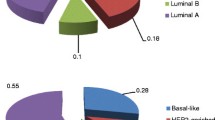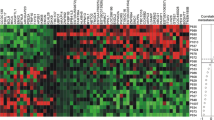Abstract
The most important predictor of prognosis in breast cancer is lymph node status, yet little is known about molecular changes associated with lymph node metastasis. Here, gene expression analysis was performed on primary breast (PBT) and corresponding metastatic lymph node (MLN) tumors to identify molecular signatures associated with nodal metastasis. RNA was isolated after laser microdissection from frozen PBT and MLN from 20 patients with positive lymph nodes and hybridized to the microarray chips. Differential expression was determined using Mann–Whitney testing; Bonferroni corrected P values of 0.05 and 0.001 were calculated. Results were validated using TaqMan assays. Fifty-one genes were differentially expressed (P < 1 × 10−5, less than twofold differences) between the PBT and paired MLN; 13 with significantly higher expression in the MLN and 38 in the PBT. qRT-PCR validated the differential expression of 40/51 genes. Of the 40 validated genes, NTS and PAX5 were found to have >100-fold higher expression in MLT while COL11A1, KRT14, MMP13, TAC1 and WNT2 had >100-fold higher expression in PBT. Gene expression differences between PBT and MLN suggests that expression of a unique set of genes is required for successful lymph node colonization. Genes expressed at higher levels in PBT are involved in degradation of the extracellular matrix, enabling cells with metastatic potential to disseminate, while genes expressed at higher levels in metastases are involved in transcription, signal transduction and immune response, providing cells with proliferation and survival advantages. These data improve our understanding of the biological processes involved in successful metastatis and provide new targets to arrest tumor cell dissemination and metastatic colonization.



Similar content being viewed by others
References
American Cancer Society (2007) Cancer facts and figures 2007. American Cancer Society, Atlanta
Ellsworth RE, Ellsworth DL, Neatrour DM, Deyarmin B, Lubert SM, Sarachine MJ, Brown P, Hooke JA, Shriver CD (2005) Allelic imbalance in primary breast carcinomas and metastatic tumors of the axillary lymph nodes. Mol Cancer Res 3:71–77. doi:10.1158/1541-7786.MCR-04-0180
Kuukasjarvi T, Karhu R, Tanner M, Kahkonen M, Schaffer A, Nupponen N, Pennanen S, Kallioniemi A, Kallioniemi OP, Isola J (1997) Genetic heterogeneity and clonal evolution underlying development of asynchronous metastasis in human breast cancer. Cancer Res 57:1597–1604
Schmidt-Kittler O, Ragg T, Daskalakis A, Granzow M, Ahr A, Blankenstein TJF, Kaufmann M, Diebold J, Arnholdt H, Muller P, Bischoff J, Harich D, Schlimok G, Riethmuller G, Eils R, Klein CA (2003) From latent disseminated cells to overt metastasis: genetic analysis of systemic breast cancer progression. Proc Natl Acad Sci USA 100:7737–7742. doi:10.1073/pnas.1331931100
Steeg PS (2006) Tumor metastasis: mechanistic insights and clinical challenges. Nat Med 12:895–904. doi:10.1038/nm1469
McGuire WL, Clark GM (1992) Prognostic factors and treatment decisions in axillary-node-negative breast cancer. N Engl J Med 326:1756–1761
Perou CM, Sorlie T, Eisen MB, van de Rijn M, Jeffrey SS, Rees CA, Pollack JR, Ross DT, Johnsen H, Akslen LA, Fluge O, Pergamenschikov A, Williams C, Zhu SX, Lonning PE, Borresen-Dale AL, Brown PO, Botstein D (2000) Molecular portraits of human breast tumours. Nature 406:747–752. doi:10.1038/35021093
Ramaswamy S, Ross KN, Lander ES, Golub TR (2003) A molecular signature of metastasis in primary solid tumors. Nat Genet 33:49–54. doi:10.1038/ng1060
Sorlie T, Perou CM, Tibshirania R, Aas T, Geisler S, Johnsen H, Hastie T, Eisen MB, van de Rijn M, Jeffrey SS, Thorsen T, Quist H, Matese JC, Brown PO, Botstein D, Lonning PE, Borresen-Dale AL (2001) Gene expression patterns of breast carcinomas distinguish tumor subclasses with clinical implications. Proc Natl Acad Sci USA 98:10869–10874. doi:10.1073/pnas.191367098
van’t Veer LJ, Dai H, vande Vijver MJ, He YD, Hart AA, Mao M, Peterse HL, van der Kooy K, Marton MJ, Witteveen AT, Schreiber GJ, Kerkhoven RM, Roberts C, Linsley PS, Bernards R, Friend SH (2002) Gene expression profiling predicts clincial outcome of breast cancer. Nature 415:530–536. doi:10.1038/415530a
Fidler IJ (2003) The pathogenesis of cancer metastasis: the ‘seed and soil’ hypothesis revisited. Nat Rev Cancer 3:453–458. doi:10.1038/nrc1098
Gupta GP, Massagué J (2006) Cancer metastasis: building a framework. Cell 127:679–695. doi:10.1016/j.cell.2006.11.001
Newman B, Austin MA, Lee M, King MC (1988) Inheritance of human breast cancer: evidence for autosomal dominant transmission in high-risk families. Proc Natl Acad Sci USA 85:3044–3048. doi:10.1073/pnas.85.9.3044
Page DL, Dupont WD, Rogers LW, Landenberger M (1982) Intraductal carcinoma of the breast: follow-up after biopsy only. Cancer 49:751–758. doi:10.1002/1097-0142(19820215)49:4<751::AID-CNCR2820490426>3.0.CO;2-Y
Nguyen DX, Massagué J (2007) Genetic determinants of cancer metastasis. Nat Rev Genet 8:341–352. doi:10.1038/nrg2101
Vecchi M, Confalonieri S, Nuciforo P, Vigano MA, Capra M, Bianchi M, Nicosia D, Bianchi F, Galimberti V, Viale G, Riccardi A, Campanini R, Daidone MG, Pierotti MA, Pece S, Di Fiore PP (2008) Breast cancer metastses are molecularly distinct from their primary tumors. Oncogene 27:2148–2158. doi:10.1038/sj.onc.1210858
Nathanson SD (2003) Insights into the mechanisms of lymph node metastasis. Cancer 98:413–423. doi:10.1002/cncr.11464
Muller A, Homey B, Soto H, Ge N, Catron D, Buchanan ME, McClanahan T, Murphy E, Yuan W, Wagner SN, Barrera JL, Mohar A, Verastgui E, Zlotnick A (2001) Involvement of chemokine receptors in breast cancer metastasis. Nature 410:50–56. doi:10.1038/35065016
Vouyovitch CM, Vidal L, Borges S, Raccurt M, Arnould C, Chiesa J, Lobie PE, Lachuer J, Mertani HC (2008) Proteomic analysis of autocrine/paracrine effects of human growth hormone in human mammary carcinoma cells. Adv Exp Med Biol 617:493–500. doi:10.1007/978-0-387-69080-3_49
Lomenick JP, Hubert MA, Handwerger S (2006) Transcription factor FOXF1 regulates growth hormone variant gene expression. Am J Physiol Endocrinol Metab 291:E945–E951. doi:10.1152/ajpendo.00128.2006
Seoane J, Le HV, Shen L, Anderson SA, Massagué J (2004) Integration of Smad and forkhead pathways in the control of neuroepithelial and glioblastoma cell proliferation. Cell 117:211–223. doi:10.1016/S0092-8674(04)00298-3
Somai S, Gompel A, Rostene W, Forgez P (2002) Neurotensin counteracts apoptosis in breast cancer cells. Biochem Biophys Res Commun 295:482–488. doi:10.1016/S0006-291X(02)00703-9
Feng Y, Sun B, Li X, Zhang L, Niu Y, Xiao C, Ning C, Fang Z, Wang Y, Zhang L, Cheng J, Zhang W, Hao X (2007) Differentially expressed genes between primary cancer and paired lymph node metastses predict clinical outcome of node-positive breast cancer patients. Breast Cancer Res Treat 103:319–329. doi:10.1007/s10549-006-9385-7
Suzuki M, Tarin D (2007) Gene expression profiling of human lymph node metastases and matched primary breast carcinomas: clinical implications. Mol Oncol 1:172–180. doi:10.1016/j.molonc.2007.03.005
Jenssen TK, Hovig E (2005) Gene-expression profiling in breast cancer. Lancet 365:634–635
Harrell JC, Dye WW, Harvell DME, Sartorius CA, Horwitz KB (2008) Contaminating cells alter gene signatures in whole organ versus laser capture microdissected tumors: a comparison of experimental breast cancers and their lymph node metastses. Clin Exp Metastasis 25:81–88. doi:10.1007/s10585-007-9105-7
Minn AJ, Kang Y, Serganova I, Gupta GP, Giri DD, Doubrovin M, Ponomarev V, Gerald WL, Blasberg R, Massague J (2005) Distinct organ-specific metastatic potential of individual breast cancer cells and primary tumors. J Clin Invest 115:44–55
Acknowledgments
We thank Drs. Darrell Ellsworth and George Iida for helpful and critical review of this manuscript. Supported by the United States Department of Defense (Military Molecular Medicine Initiative MDA W81XWH-05-2-0075). The opinion and assertions contained herein are the private views of the authors and are not to be construed as official or as representing the views of the Department of the Army or the Department of Defense.
Author information
Authors and Affiliations
Corresponding author
Electronic supplementary material
Below is the link to the electronic supplementary material.
Rights and permissions
About this article
Cite this article
Ellsworth, R.E., Seebach, J., Field, L.A. et al. A gene expression signature that defines breast cancer metastases. Clin Exp Metastasis 26, 205–213 (2009). https://doi.org/10.1007/s10585-008-9232-9
Received:
Accepted:
Published:
Issue Date:
DOI: https://doi.org/10.1007/s10585-008-9232-9




